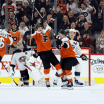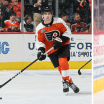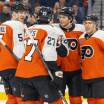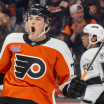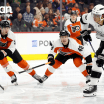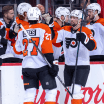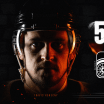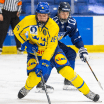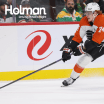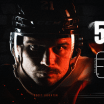The Philadelphia Flyers went 7-2-1 in January; the 11th time in franchise history the team has had 15 or more points through the first 10 games of the season and the first time since 2002-03 (7-1-2, 16 points). The club has won each of its last four games, following back-to-back regulation road wins against the New Jersey Devils and overtime home victories over the New York Islanders. In that span, the Flyers have not played anything close to their best hockey overall, unlike November 2019, when Alain Vigneault's club posted the NHL's best record for that month and underlying process was very strong. That surge was later followed by a 19-6-1 run in the 23 games leading up to the regular season pause.
Flyers Thru 10: What's Working, What Needs Improvement

This time around, the Flyers are, quite frankly, rather lucky to be above 8 points through 10 games, much less at 15. The overall way the Flyers have played is not sustainable for winning consistently in the regular season nor would it be conducive to preparing for a deep run in the Stanley Cup playoffs. The Flyers are well aware of this. players and coaches alike.
Head coach Alain Vigneault said it best before the Jan. 30 game against the Islanders.
"I came here to Philly to win a Stanley Cup, and to win the Stanley Cup, there's a certain way you have to play," he said. "We are winning and we are scoring goals but there's a 200-foot game you need to play. Right now, especially in talking to the forward group, we need to get better. There's certain decisions you have to make, with and without the puck. That's what I'm here to do and that's what I'm going to get out of this group."
Hockey is a results-oriented business; on a game-to-game basis it's the two standings points that matter more than that night's puck possession and shot quality generated or yielded analytics. In a shortened season -- with 10 games down, there are 46 left to go -- it is imperative to put as many points in the bank as quickly as possible. This is especially true with the entire schedule being playing within one's own division and also vital given this year's playoff format of the first, second, third and fourth place teams in each division being the only ones who qualify for the postseason. There are no wildcard spots this season.
Of course, in order to win seven of 10 games, there are things that a team must be doing right. That's the case here with the Flyers. The following is a look at four areas that have led to the team's strong early record, and four aspects that need improvement if the team is to be able to sustain its early winning ways.
WHAT'S WORKING
1. Pucks and attackers to the net
The Flyers have not generated nearly the quantity of shots they'd want to have. This has been primarily due to deficits -- sometimes severe ones -- in puck possession and secondarily due to needing more players to take a "shoot first" mentality when there's a lane. However, so far at least, the Flyers have been extremely opportunistic and efficient in finishing off their chances.
The team's current 13.1 percent rate of scoring on 5-on-5 shots (tied with Vancouver for tops in the NHL) is going to be very hard to sustain. So far, the Flyers really haven't encountered any games where the opposing goalie gets red hot and only one (Sunday's rematch with the Islanders) in which multiple shots off the crossbar or goal post stay out of the net and are recorded as missed shots.
Nonetheless, there are reasons why the Flyers are averaging 3.50 goals per game through 10 games. First and foremost, this has been due to how well the team has done in getting pucks and bodies to the scoring areas. They've executed several give-and-go plays to perfection for point-blank goals and also have scored quite a few deflection goals.
Here is one example: On the second period tally that completed Joel Farabee's hat trick on Sunday against the Islanders, the Flyers had two layers of traffic -- Scott Laughton at the net and Farabee moving across the slot for a screen/deflection opportunity -- as Phil Myers measured his shot. The result was a Farabee tip and a goal that gave the Flyers a 3-1 lead.
Fara3️⃣.#AnytimeAnywhere | #NYIvsPHI pic.twitter.com/8K5Zz04AaT
— Philadelphia Flyers (@NHLFlyers) February 1, 2021
A second example: The Flyers neutral zone forecheck is an area that needs improvement but works very effectively here as Scott Laughton and Travis Sanheim force a neutral zone turnover by the Islanders' Cal Clutterbuck in the first period of Saturday's game. That is something the Flyers need more of as the season continues; more sustained offensive zone forechecking and a stout neutral zone forecheck to create short ice in transition. But it's the rest of this particular play that makes it highlight reel worthy. The give-and-go sequence with Claude Giroux and goal-scorer Jakub Voracek is executed beautifully.
Poetry in motion. #AnytimeAnywhere | #NYIvsPHI pic.twitter.com/wJl9vo0IRb
— Philadelphia Flyers (@NHLFlyers) January 31, 2021
2. Strong goaltending
For the most part, the Flyers have received strong goaltending from Carter Hart and Brian Elliott through the first 10 games. We'll discuss Elliott first because he's been lights out in all three of his starts to date; locked in on his angles, tracking the puck very well and in control of his rebounds.
Hart, meanwhile, has played better than his mediocre stats (3.33 GAA, .900 SV%, 4-2-1 record) suggest. Among his seven starts, four have been good to very good (the opening two wins against Pittsburgh, the second win over the Devils and the first win over the Islanders). One was outstanding for two periods -- the 5-4 shootout loss in Boston, where he took a shutout into the third period -- and then saw the team in front of him fall apart to the point where only one of the four goals (a Charlie Coyle goal that tied the score at 2-2) was a stoppable one from a clear-sighted angle.
The game from which Hart was pulled in the second period after giving up four goals to Buffalo in an eventual 6-1 loss was one in which the team played very poorly in front of the goalie and Hart's own timing was just a little bit off. It was similar in the 6-1 debacle in Boston. The Flyers left Hart hung out to dry time and time again. The goalie was not egregiously off his game but just enough so that pretty much every significant scoring chance ended up in the net. The fifth Boston goal, a power play short-sider by Brad Marchand, was a nice shot from a proven goal scorer but one that Hart could and should have stopped. The built-up disappointment and frustration from the third period of the first Boston game and the all-around struggles of the second game triggered the normally serene Hart's emotional, stick-smashing outburst at the end of the game. It was very uncharacteristic but it was also cathartic.
Hart's history after subpar performances is one of quick bouncebacks, and that was the case yet again. His last two starts have been quite solid. Taken as a seven-game sample, Hart needs a little more consistency from game-to-game than he's shown over the first 10 and to come up with just a few more of the "not easy but not impossible" saves. But if the team in front of the goalie does its job, Hart's stats will trend back to meeting the high expectations that were set before the season. Overall, the combined body of work of Elliott and Hart over the first 10 games has been a strength of the team.
3. Different heroes on different nights
Even without the services of Selke Trophy winning center Sean Couturier -- one forward whom the Flyers could ill-afford to lose and whose absence has undoubtedly hurt the team's 200-foot game and lineup balance across all game situations -- the Flyers have had different lines and individual players step up on different nights. After 10 games, James van Riemsdyk leads the team with 13 points (5g, 8a) and there are six players who have at least eight points to date. Ten players have posted at least five points.
In the Flyers' second win in New Jersey, Vigneault benched Kevin Hayes' line for much of the third period because he was unhappy with how the Hayes and Nolan Patrick lines were playing, which was followed by a one-game healthy scratch of Travis Konecny who had been struggling in his two-way play and was also falling into an offensive mini-slump (a combined one shot on goal and zero scoring chances in the three games leading up to his one-game removal from the lineup). Instead, Vigneault extensively deployed the fourth-line trio of Michael Raffl, Connor Bunnaman and Nicolas Aube-Kubel, and they delivered not only the game-winning goal (scored by Raffl) but tenacious checking.
Other nights, it's been core-group veterans who have led the way. Claude Giroux was a force in the first game in New Jersey including three assists. Jakub Voracek has also had several outstanding games in the early going, including the first match in Boston. Hayes' two-way game has been inconsistent so far including a few too many low percentage plays with the puck but his PK-specific work has been outstanding at times (as it was last season). You also can't argue with his offensive bottom line: Five goals and 10 points including the overtime winner against the Islanders on Sunday.
Joel Farabee opened the season with a career-best four-point night (1g, 3a) against the Penguins. Last game, he recorded his first career hat tricks and became one of the youngest players in franchise history to accomplish that feat. Travis Sanheim has played well defensively of late, and the lineup returns of Shayne Gostisbehere after a bout with COVID-19 and Phil Myers after suffering a rib injury in the second game against Buffalo have been a help to a blueline that struggled mightily through most of the first eight games of the season.
4. JVR and Ghost bouncebacks
Many Flyers players thrived during last year's breakthrough regular season campaign and the team's drive to getting within one victory of the Eastern Conference Finals. James van Riemsdyk and Shayne Gostisbehere were not among them. JVR had one of his roughest NHL seasons a year ago and was a healthy scratch several times in the playoffs after a struggling Phase 3 camp. Gostisbehere had his second straight disappointing season and only dressed in a few playoff games.
There were some extenuating circumstances. In Gostisbehere's case, the player had to have surgeries on both knees -- one in season and the other during the pre-playoff pause -- and he was neither skating well nor playing with much jam. Although he's never been a pure speedster in a straight line, Gostisbehere's lateral mobility is a big part of his game. So, too, is his offensive aggressiveness and his ability to break up opposing entry attempts near the defensive blueline to start counterattacks the other way. The three keys to Gostisbehere's success are to help keep the puck out of the Flyers zone in the first place (own zone, off-puck play has never been not his strong suit as a player), to make good passes to allow forwards to attack with speed and to join the play up ice with his heavy one-timer.
Although Gostisbehere isn't lighting up the scoresheet so far (in part because he's no longer on the first power play unit), he's worked well together with Ivan Provorov so far. They were a highly effective duo in the second half of the 2017-18 season until a rough playoff series for "Ghost" and a shoulder injury for Provorov in Game 5 of their playoff series with Pittsburgh. The duo struggled, both collectively and individually, in the first month or so of the 2018-19 season leading eventually to the pair being split. At least for now, their reunion has worked.
In the first game against the Islanders, it was Gostisbehere who set the wheels in motion for the game winning overtime goal by Laughton. Gostisbehere showed a quick defensive stick to break up a play just inside the Flyers blueline. He then triggered a counter opportunity for Laughton to score his first goal of the season and lift the Flyers to victory.
Sgt. @Laughts21 found the perfect time to net his first marker of the season. #AnytimeAnywhere | #NYIvsPHI pic.twitter.com/UPN5GcVJcd
— Philadelphia Flyers (@NHLFlyers) January 31, 2021
In van Riemsdyk's case, the player never hit a sustained offensive groove last season. He did work hard to pick up his off-puck play and had an underrated 2019-20 season in that regard, but JVR is a player who is first and foremost expected to be a goal producer. JVR had various things to deal with last season -- the arrival of a newborn, the construction of a new house, and being one of the NHLPA representatives on the return-to-play committee -- that would be challenging for any player to be at their very best after the pause, although he refused to make any excuses. JVR was a healthy scratch several times during the playoffs.
This season, JVR has been a real difference maker for the Flyers. He's played well on both sides of the puck. Offensively, he's creating chances for teammates (including his four-assist game on Sunday against the Isles) and he's getting to the "greasy" areas for deflection goals. He has forechecked well, moving in with a purpose. Without the puck, he's worked hard to make the right reads and go to the correct spots. He'll never be a player who will rattle the boards with crushing hits despite his big frame but JVR has also been physically engaged so far this season and has checked effectively.
WHAT NEEDS IMPROVEMENT
1. Puck possession in general
Last season, Vigneault's Flyers were the NHL's stingiest team in terms of shots allowed per game. That was the result of good structure and team-wide buy-in to things such as short, disciplined shifts that enabled the team to play with good pace. The offensive zone and neutral zone forechecks created a lot of opposing turnovers and one-and-done rushes while the situating of Sanheim and Myers as the second pair supporting Ivan Provorov and veteran Matt Niskanen gave Philly a solid top four with every player in the appropriate role. Philly also was able to roll out three workable D pairs and had three left-handed and three right-handed defensemen.
This year, the structure, the execution and the discipline have just not been there. The Flyers have been out-possessed, out-shot (in all but one game) and outchanced by a significant margin in the first 10 games. Some of it is Couturier's absence since the first period of the second game. Some of it is the effect of Niskanen's early retirement following last season and missing the all-situations minutes and calming demeanor he brought. Some of it is probably the nature of what's gone on leaguewide after every team had short camps and no exhibition games; there hasn't been much time for systems reinforcement at practice especially given the high volume of games with short turnarounds. There are a lot of breakdowns and goals on a nightly basis, not just in Flyers games but for a large portion of clubs.
The bottom line, however, is that the Flyers cannot continue to get out-possessed like they have and hope to sustain their winning ways. Additionally, the Flyers have struggled to deal with matchups against heavier, more physical teams. Given the composition of the roster, that's something that will have to be worked around against clubs like the Islanders, Bruins or Capitals. The work-around is to execute well on exits, do some more initiating of contact (as the team did in the second game against Buffalo), and generally do more dictating and less reacting. When in possession of the puck, follow the time-honored philosophy that if the open ice is in front of you, make a play. If it's behind the defenders, get the puck past them and live to fight the next battle if need be.
In too many games so far this season, the Flyers have lost those second and third battles that end up swaying the balance of the puck possession edge. In the defensive zone, every time there's a breakout (or at least clearing) opportunity that fails, the odds of an opposing goal, prime scoring chance, opposing power play opportunity or a forced icing that leaves tired players on the ice against a fresh opposing line increases. Unforced icings, of which Philly in general has been guilty too often and a player such as Robert Hägg has individually been a too-frequent culprit, also add up in wearing your own team down.
2. Pace and shift discipline
Rewatch the first period of the Flyers first game against the Islanders and the second period of Sunday's game. These were arguably the Flyers two best-played periods of the season to date. Why was that? Because the Flyers were playing with pace, and forcing the Islanders to back into their own zone. Philly outskated the Islanders in those two particular periods and the result was a lot more Flyers' attack and a lot less time spent defending. The team needs many more periods such as these two.
In order to do this, everyone has to be committed to providing puck support, to keeping their feet moving rather than getting stationary and to not overstaying shifts. From 2018-19 to 2019-20, Flyers players trimmed their average shift times by roughly three seconds. They still skated the same number of total shifts but just kept them shorter in duration. This was a hidden key to why the Flyers were one of the NHL's best third period teams last year and, combined with structure, why the Flyers were a much-improved closeout team.
The Flyers are capable of playing with better pace for more than a sporadic period here and there. They also need to get back to every player being self-disciplined in avoiding unnecessarily long shifts (sometimes it can't be avoided). Do that at the puck possession differentials will start to swing back to the Flyers' favor. The good news is that there have been steps taken in the right direction in both puck support and pace in the first New Jersey game and portions of the last two games. It's a building block that will be vital to keep improving upon.
3. Closeouts
Although the Islanders, even last year, had a knack for pulling off comebacks against the Flyers, Philly was a very good closeout team when leading in the third period against most of the rest of the league. Strong closeouts against Montreal were a big key to three of the Flyers' four victories in the series, although the team was outplayed overall in too many of the games in that series. The aforementioned elements plus goaltending are the crucial elements to being a good closeout team.
There haven't been many games so far this season among the Flyers' seven wins where it felt like the team was in full control with a one-goal or two-goal lead. Elliott's 40-save shutout was once such game, simply because he was so locked in. The Flyers pulled away from Pittsburgh in the opening back-to-back but that was more about opportunism and strong play by Hart than about making the Penguins fight for every inch of real estate in the third period and forcing them to defend more than attack.
To date, the Flyers only lost point in their grasp was the four-goal third period they gave up in Boston after leading by scores of 2-0 and 3-2 before JVR rescued one point with a late game-tying goal. Moving forward, the Flyers cannot afford to see as many third period leads evaporate as they have so far this season. It will bite them if it keeps happening.
4. The Niskanen Effect
Of all of the issues we've discussed, the challenges created by Niskanen's retirement are the ones that were of the greatest concern before opening night and have proven justified. There was -- and still is -- no one defenseman on the roster who can check all the boxes Niskanen checked as Provorov's partner: right handed, above-average both defensively and offensively, selectively physical, a proven leader who owns a Cup ring, a first PK rotation and second PP unit regular, and a leader by example and demeanor. A committee approach was needed for various players to elevate their own games to fill specific aspects of what was lost.
So far, that hasn't happened. Gostisbehere's strong play so far and chemistry with Provorov has helped in terms of puck movement and enabling the Sanheim-Myers pair to stay together but more consistency is needed both from the D corps and in terms of forwards doing their part to stop the other team from scoring, to exit the defensive zone with cohesion and navigate the neutral zone with pace and good decision-making. It really HAS to be a team effort with the current personnel mix.
Erik Gustafsson has five points in eight games, and all five points have been well-earned: three well-executed point shot wristers that resulted in deflection goals, a slap pass that Claude Giroux tipped home, and a tape to tape stretch pass in the second game against Buffalo. Unfortunately, Gustafsson's play otherwise has been lackluster. He's struggled with gap management, in handing the opposing forecheck, in breaking up plays with his stick even when he has a good gap, and in forcing plays that go for turnovers. That's not going to keep the veteran in the lineup on an every-game basis. Hägg has also struggled at times in the early going. The Flyers need him to win battles on the walls, box out well in front and play a very simple game with the puck.
Sanheim's play has been good of late, and he needs to continue with it. Myers' return restores a well-balance duo to the middle pair. Both players are still striving for increased consistency on both sides of their game. Hopefully, things continue to trend the right way.
Veteran defenseman Justin Braun struggled mightily at the opening of the season but has played better of late. Third pairing minutes and PK duties suit him best at this stage of his career although he can move up for short stretches in a pinch.
Mark Friedman had a so-so training camp but made the opening night roster on the strength of impressing Vigneault with his work in brief NHL stints and the Flyers' hockey ops department with his year-to-year improvements with the Phantoms. Friedman went 10-plus months between games from the time the AHL season was suspended and ultimately canceled last season due to the pandemic and his return to the Flyers starting lineup against Boston and New Jersey. He was injured in the first game and removed as a precaution. His second game was rough, as he looked tentative and rusty (not unexpected after such a long layoff). His third was a bit better but described by Vigneault as lacking the physical "bite" and quick pace that the coach had previously seen in him. With Friedman, when he eventually gets back in the lineup, using his wheels, deceptive physical strength (despite his lack of height, Friedman is physically strong) and his aggressiveness to his advantage.
The surprise one-game NHL appearance of veteran Nate Prosser, including a rare goal by the stay-at-home blueliner on a set play off a faceoff and four minutes of solid PK work, gave the Flyers a lift in New Jersey. However, Prosser is not expected to be anything more than a player who can deliver a structured, predictable and competitive outing in a pinch. He's not a candidate to be a lineup regular in the NHL at this stage of his career.
This says it all: The Flyers have already used as many defensemen in 10 games this season as they used for the entirety of last season. Working around the retirement of Niskanen and rebalancing the minutes and assignments across three starting pairs is very much still a work in progress that is lessened but not fully alleviated by Gostisbehere's strong start and the return of Myers from injury.

